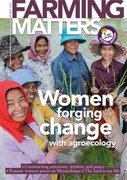In most cultures, the home gardens are women’s territory. Pablo Tittonell describes how female farmers safeguard the most important inheritance we may receive, one that is essential for agroecology, for future food and for nutritional security: cultural and biological diversity.
I always have to think about the etymology of the terms ‘economy’ and ‘ecology’ when I see a home garden. The home garden is a highly diversified environment within a farm where crops used in the kitchen are grown in association with others. Soils of the home gardens are often more fertile than the surrounding fields of the farm, and its structure, biological diversity, organic matter and nutrient contents have often been ‘upgraded’ through years of care and proper management, even in areas where soils are inherently poor. Home gardens are often the only green spot on the farm in dry years.
In most cultures, the home gardens are women’s territory. They contribute enormously to food security and nutrition through the diversification of diets, producing food even outside of the growing season, and producing ‘forgotten’ traditional crops. Home gardens are also crucial to secure food and livelihoods for older women. In both monogamous and polygamous families of East Africa every wife owns a home garden. It is often the only thing she will inherit once her husband dies and her children move away or take over the farm. From this perspective, there is no doubt that the investment in building up soil fertility pays off in the long term.
A study done in two ethnically different villages in western Kenya by one of my former students shows how local vegetables that are often regarded as ‘weeds’ in agronomy are a source of vitamins and minerals for the farming families (Figueroa-Gomez, 2008). The study also revealed that women knew a lot more edible species than men. These local vegetables, some of them known exclusively by women, constitute an essential resource in times of scarcity. Through hosting a wide diversity of plant species and cultivars, home gardens are also crucial for the conservation of agrobiodiversity.
Home gardens are organised by the rules of the kitchen in order to have fresh and diverse food all year round. And here is where economy (the management of the household) and ecology (the knowledge of the household) converge. This is how female farmers from all over the world are contributing to safeguard the most important inheritance we may receive, one that is essential for agroecology, for future food and for nutritional security: cultural and biological diversity. Thanks mama!
Pablo Tittonell
Pablo Tittonell (www.pablotittonell.net) is coordinator of the National Program on Natural Resources and Environment of INTA in Argentina and Professor of the Farming Systems Ecology group at Wageningen University and Research Centre, the Netherlands. He is a board member of the African Conservation Tillage network and member of the Latin American Scientific Society on Agroecology (SOCLA).
This was the last column of Pablo Tittonell in 2015. We thank Pablo for his insightful and thoughtprovoking contributions throughout 2015 and we will continue to work together with Pablo in strengthening agroecology.

